Blog for the reenactors of the 4th US Regular Infantry, keeping Civil War history alive in Washington State.
Wednesday, September 23, 2015
Event: Kennewick Living History
Some of our members made the trip out to Kennewick last weekend for the final WCWA living history event of the season. Roy's impression of General Lee appears to have (as usual) been well-received.
Parlor Games
| Hunt the Slipper (1860) by F. Goodall |
Elements: Players sit in a circle. One player has a soft ball (knotted handkerchief, etc., something that can be tossed easily and without harm). The player calls out an element--"Air", "Fire", "Water", or "Earth"-- and immediately throws the ball to another player. Upon catching the ball, that player must name a creature that moves through that element, or stay silent if "Fire" is called. If performed correctly, he or she throws the ball to yet another player, while naming a new element. Players must perform a forfeit if they answer incorrectly (such as by saying "trout" in response to "air"), repeat an earlier answer, fail to answer within a reasonable time, as determined by the group, or fail to name an element when tossing the ball. Traditionally, forfeits are marked during the game by surrendering a recognizable possession like a glove, fan, or initialed handkerchief. Afterwards, to retrieve the item, the person must complete a task assigned by the group; it is often a silly one, such as standing on one foot while reciting a nursery rhyme. Other favorites include singing in a high voice, complimenting various members of the party, etc. Many of the period instructions include kissing, which for some reason isn't popular with 21st century players...
Barnyard Animals (as played by LHSMN; I haven't found the original source, but it closely resembles "My Lady's Toilet" from The Sociable and "Animal Club" from Sports and Pastimes): Players sit in chairs in a circle, with one person standing in the center. Each player selects a uniquely-named barnyard animal. The central player begins telling a story of his/her own devising. When an animal is named, the corresponding player must rise from his/her seat, turn once in a circle while making that animal's noise, and sit back down. At the phrase "all the barnyard animals", the entire company rises, spins while making noises, and then finds a new place. The last player standing continues the story, while the previous storyteller resumes his/her animal role (or assumes a role, if he/she was the starting storyteller).
Biz: The players sit a circle. At the outset of the game, a number such as 4 or 7 is selected; any number 2-9 will work. They proceed to count around the circle, each saying one number, save that "biz" replaces the pre-selected number, as well as multiples of that number, and any number containing the forbidden digit. Choosing 4, for instance, eliminates, 4, 8, 12, 14, 16, etc., including all of 40-49. Players who make a mistake must pay a forfeit. For thematic fun, select a phrase such as "Merry Christmas" or "Fort Nisqually" instead of "biz". The game is often played to 100 (50 with small children).
Packing a Trunk: The players sit in a circle, and the first player starts by announcing that he/she is going on a trip and will pack some item starting with an 'A' in his/her trunk. The next makes the same announcement, adding a 'B' item to the list. The players continue around the room through the letter W (X, Y, and Z being very difficult, they are often omitted; the book also recommends skipping other troublesome letters like Q, but plenty of us remember to pack quilts, quinces and quinine, so this is not necessary). As usual, forfeits are assigned for forgetting an item, using the wrong letter, and so on.
I Love My Love With An A: This is another alphabetical wit game. Categories are selected at the beginning (3 or more), and each player must explain why/how they love a person, and what they will do about it, using words starting with that letter. To wit: "I love my love with an 'A' because he is adorable, because he is named Alfred, and because he is an author. I will give him an anchor, feed him anchovies, and crown him with anemones." Forfeits apply, for forgetting a category, mis-spelling a word ("I love my love with a 'u' because his voice is 'euphonious'), or otherwise messing up. Again, troublesome letters may be skipped, but the group should decide in advance which ones will be omitted.
Blind Man's Bluff: There are several variants of this one, though a good version among close friends has everyone sitting on chairs in a tight circle. The blindfolded person is in the center of the group and must sit down on one of the chairs; he or she has three tries to guess whom he/she is sitting on. This is mainly accomplished by observing the presence/absence of hoops and listening for everyone else's laughter. Another version gives the person a stick, and has the others standing in a circle with clasped hands. They may move around, but not drop hands. The 'blind man' moves the stick, tapping members of the company and trying to guess who is being hit.
Period Books
The Sociable, or 1001 Home Amusements (1858)
A Week's Delight or Games and Stories for the Parlor and Fireside (1859)
Fireside Games: For Winter Evening Amusement (1859)
Parlour Pastimes for the Young (1859)
Sports and Pastimes for In-Doors and Out (1863)
Every Boy's Book (1860) contains some parlor games as well as more athletic activities.
Ditto The Little Boy's Own Book of Sports, Pastimes, and Amusements (1860)
On a related note The American Hoyle or Gentleman's Hand-Book of Games (1864) contains rules and strategies for various card games, and other pursuits associated with men (billiards, chess, backgammon). Whether you play them in the parlor, or not, is of course, up to you...
Parlor "magic" and science demonstrations make up their own (related) category of recreation in the period. See Parlour Magic (1858), The Boy's Own Conjuring Book (1860), and The Fashionable Science of Parlour Magic (1855), which also purports to explain gamblers' tricks and spiritualist phenomena.
Period magazine, particularly those aimed at youth or with a "Juvenile Department" will sometimes feature new games and amusements.
*In addition to being available free on-line (see above), a reprint of this title is available through Ragged Soldier Sutlery.
Tuesday, September 15, 2015
What's Your Job?
 |
| Blacksmith with tools, c. 1852. Note the vest, scarf and rolled sleeves. Image from The Design Observer Group. |
These Dated Images from the 1840s and 50s show a diverse range of trades and professions.
There are also slideshows of occupational images from the1840s/50s On Youtube.
The American Daguerreotype Society has fewer images, but with more commentary on them.
And there are more pictures here, but without useful contextual information.
These 1860s Russian CDVs show a great diversity of jobs and tools, with a mixture of traditional Russian and modern European dress--look to other sources for collaborating stylistic choices, unless you're portraying a very recent immigrant.
Women's occupational images. (For more about jobs open to women, check out Virginia Penny's 1863 book "The Employments of Women").
Illustrations of poor Londoners, 1851. These include working people and the indigent.
The Library of Congress's Daguerretype collection: enter the occupation of interest, and voila!
Sunday, September 13, 2015
Event: Mt. Rainier Scenic Railroad
It's been a busy end-of-summer for the 4th, with four engagements over the last five weekends. The most recent was a "Civil War Train" living history event with the Mt. Rainier Scenic Railroad Museum. The blogmistress, alas, was stuck some 10 years in the past and thus missed the event, but Mr. Strand's images suggest a successful venture. At the very least, Corporal Van Houck managed to pose dramatically for a number of shots, and several of our favorite Rebs also made appearances.
 |
| A good turn out of Union boys. And one very brave rebel. |
 |
| The younger recruits show great enthusiasm for... something. |
Thursday, September 10, 2015
The Written Word
For those interested in sending and receiving letters, the National Civil War Association has some patriotic stationary and era-appropriate stamps (both Union and Confederate) that one may print for free.
A larger selection is available for sale at Sullivan Press, along with reproduction labels, government forms, reprinted books, and stationery supplies.
Ragged Soldier Sutlery carries reprinted books and school supplies (including copybooks for period penmanship).
For those interested in making their own labels, pamphlets, etc., The New Blazing Star Press carries font CDs (all characters apparently scanned from original documents).
IAMPETH has some free lessons and resources for learning Spencerian and Copperplate scripts. Spencerian was being taught in schools during the 1860s, while older adults would have learned a form of Roundhand (also called Copperplate, though that technically refers to printed rather than handwritten lettering).
Wednesday, September 9, 2015
Event: Fort Worden Living History
The 4th US attended a new event Labor Day weekend--a 3-day, multi-era living history at Fort Worden State Park. Joining us in the 1860s were the USS Tahoma Navy, the 1st Texas Infantry, and the Confederate Engineering Corps. Other groups representing WWI, WWII, and diverse army vehicles were also present. The Civil War component was organized by Liz and John Strand.
The event was a interesting on multiple levels. The historic fort offered an excellent parade ground for camping and skirmishes, as well as slightly-post-period historic housing with some modern amenities. The mixed-era event attracted an exciting mix of knowledgeable and novice visitors, while the more intimate scale allows members of different companies (and time periods!) a chance to meet each other. There were a number of weddings also scheduled in the park that weekend, and a joint Union/Confederate effort enabled one of them to feature a very special saber display--with less than 15 minutes notice.
Evening programming in the 1940s USO hall gave everyone a chance to relax and socialize: it included two period dances, a round of Victorian parlor games, and a birthday party for young Mr. Walker. I'm sure none of us will easily forget Mr. Talbott (as General Lee) imitating a rooster for the amusement of the company.
 |
| The Confederates hold their position during a skirmish. |
 |
| Captain Jones addresses the troops |
 |
| A firing demonstration. |
 |
| Union infantry (4th US) in camp. |
 |
| The USS Tahoma's "Land Ship" intrigued visitors. |
 |
| The navy in action. |
 |
| Navy encampment on the parade ground; Fort Worden's late Victorian officers' quarters appear in the background |
 |
| The field hospital enjoyed more permanent surroundings than usual. |
 |
| Medicine chest on display in the field hospital. |
 |
| Nurse Keyes comforts a mourner. |
 |
| The civilian display also included an extensive fashion section. |
 |
| Mrs. Talbot battled yellow jackets at the USAS tent to keep everyone supplied with lemonade, pickles and cookies. |
 |
| The Virginia Reel was popular during Saturday evening's dance. The Broken Dreams provided live music. |
 |
| Having our image struck. |
Apologies to the Confederate Engineers and the 1st Texas Infantry for the paucity of camp photos--the author's camera didn't make it out of civilian land until after our friends in gray had to pack up Monday.
Tuesday, September 1, 2015
Bonnets and Other Women's Headgear
"...Although hats are now worn even in Paris, the former [bonnets] are still preferred for vists of ceremony, concerts, &c., even at the sea-side."
 |
| Godey's, June 1860 |
This is a basic introduction to a vast topic. For examples of women's hats, see this post.
In general terms, I tend to divide women's bonnets and similar garments into "hard" and "soft" categories. The later includes structured bonnets of buckram, straw, cane, etc., often fashionably shaped and decorated, while the latter includes various unstructured fabric and knit garments such as sunbonnets and hoods. Though I call them "unstructured", these still may have quilting, cording, pasteboard/paper slats, or other stiffening agents, particularly around the brim. Indoor attire (including caps and adornments such as nets or wreaths) will be dealt with separately.
Hard and "Fashion" Bonnets
These change shape throughout the war years; generally speaking, the low, round-brimmed bonnets of the '50s start rising above the forehead and narrowing along the cheeks, forming the "spoon" bonnet of the early '60s. This peaks, pun intended, around 1863-4, and fashionable bonnets branch off in two radically different directions during 1865: the Empire bonnet with a variety of brim shapes and a solid crown, and the small, crown-less, almost-triangular fanchon bonnet, which anticipates the tiny hats and bonnets of the '70s.
What went before:
Bonnets of the '40s tended to have long, straight brims (parallel to the ground, little/no flaring) which extend past the face. Decoration is heavy on the outside of the brim, with perhaps some token ruffles around the face. The fashionable face shape tends to "long", and the bonnets reflect that. This is also the last time fashionable bonnets really shade the face.
 |
| Peterson's Magazine, Dec. 1849 |
 |
| "Evening Bonnet", c. 1847 |
In reaction, bonnets of the '50s retreat back, exposing the face and hair. Some even appear to be falling off the back of the head.The brim shape gets rounder over the cheeks and sits low over the head, emulating the fashionable round face. To fill the space, lace and floral trimming appears under the brim, particularly along the sides of the face. This shape reaches its zenith in the mid-'50s, after which the brim lengthens and begins to climb.
1860: Bonnets still sit back from the face, though the brims rise slightly higher than before. Under-brim decoration, where present, still concentrates at the sides or extends all around the face. Exterior trim is low on the brim, near the crown.
1861: Brims are rising, interior trim is starting to move from along the cheek to above the forehead, and exterior trim may be all over the bonnet.
1862: Brims continue to grow upward, allowing for larger quantities of trim above the forehead, while narrowing sides reduce the amount along the cheek. Exterior trim is commonly placed high on the brim as well. Curtains slowly shrinking.
1863: Tall brims are still in, curtains shrink noticeably. Trim is lavished on the brim and curtains, and though not exclusive, continues to emphasize the height of the brim. "Marie Stuart" bonnets, with the brim dipping inward at the center top, are written about, but rarely pictured.
1864: The "spoon bonnet" reaches its high-water-mark, and begins to implode. Curtains are shorter than ever, and some bonnets are made with soft, unstructured crowns. Trim focuses on the high brims, but may also cascade down over the exterior of the bonnet.
 |
| Straw bonnet, 1855 |
 |
| Bonnet, Graham's Illustrated Magazine, 1857 |
1860: Bonnets still sit back from the face, though the brims rise slightly higher than before. Under-brim decoration, where present, still concentrates at the sides or extends all around the face. Exterior trim is low on the brim, near the crown.
 |
| "Broadway Bonnet", Arthur's Home Magazine Spring 1860 |
 |
| Frank Leslie's Monthly Magazine, Jan 1860 |
 |
| Detail from The General Post Office, One Minute to Six (1860) by G. E. Hicks |
 |
| Detail of Mrs. William Page by W. Page, 1860-1 |
1861: Brims are rising, interior trim is starting to move from along the cheek to above the forehead, and exterior trim may be all over the bonnet.
 |
| Straw bonnets, Godey's, March 1861 |
 |
| Godey's, November 1861 |
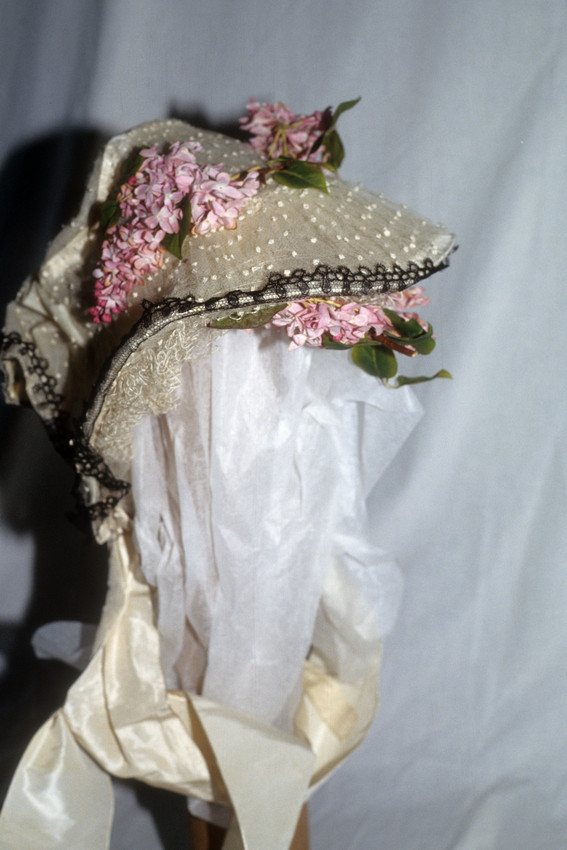 |
| Bonnet, 1861-2 |
1862: Brims continue to grow upward, allowing for larger quantities of trim above the forehead, while narrowing sides reduce the amount along the cheek. Exterior trim is commonly placed high on the brim as well. Curtains slowly shrinking.
 |
| Frank Leslie's Ladues' Magazine, Jan 1862 |
 |
| Bonnets in Der Bazar, April 1862 |
 |
| Detail from The Railroad Station (1862) by W. P. Frith |
1863: Tall brims are still in, curtains shrink noticeably. Trim is lavished on the brim and curtains, and though not exclusive, continues to emphasize the height of the brim. "Marie Stuart" bonnets, with the brim dipping inward at the center top, are written about, but rarely pictured.
 |
| Bonnets from La Mode Parisiennes, 1863 |
 |
| "Marie Stuart" bonnet from Le Moniteur de la Mode, 1863 |
 |
| The Ladies' Companion, 1863 |
 |
| Godey's, November 1863 |
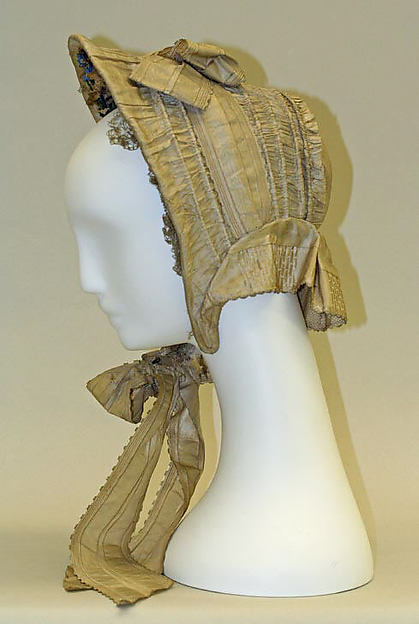 |
| Silk Bonnet (form likely buckram or net), 1863 |
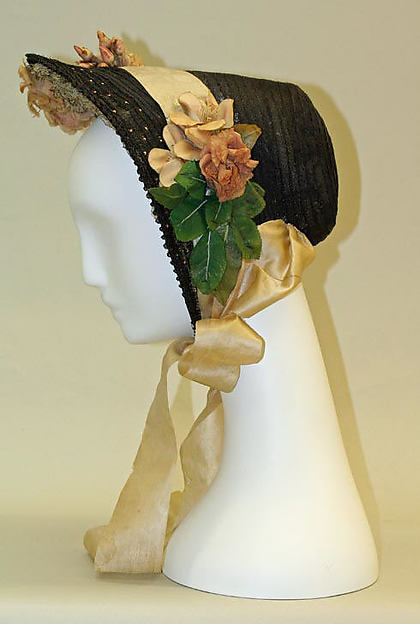 |
| Horsehair Bonnet, 1863 |
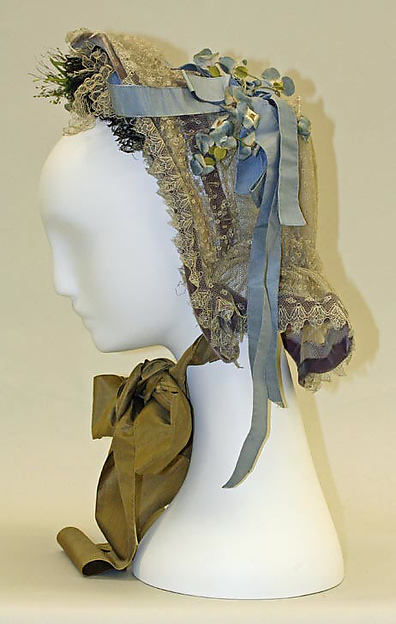 |
| Silk bonnet, 1863 (buckram or net form) |
1864: The "spoon bonnet" reaches its high-water-mark, and begins to implode. Curtains are shorter than ever, and some bonnets are made with soft, unstructured crowns. Trim focuses on the high brims, but may also cascade down over the exterior of the bonnet.
 |
| High "spoon" bonnets in Godey's, Jan 1864 |
 |
| Godey's, Feb. 1864; a soft crown bonnet (left) |
 |
| The new "curtain-less" bonnet, The Lady's Friend, Oct 1864 |
1865: Two rival bonnet forms come into play: the 'fanchon', or 'half-handkerchief', which allows plenty of room for elaborate hairstyles; and the 'Empire bonnet', which, along with higher-waisted bodices and narrower skirts, celebrates the Second French Empire by evoking the styles of the first. Both styles undergo rapid changes in shape during the year. Additional examples of 1865's evolving fanchon are here.
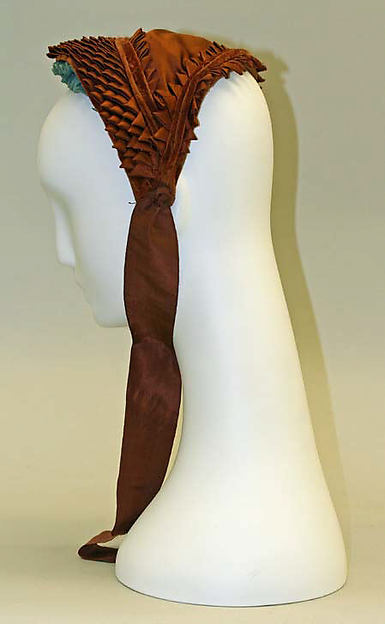 |
| Fanchon bonnet, c. 1865-8 |
 |
| Fanchons in Peterson's, January 1865 |
 |
| Empire bonnets, Peterson's, December 1865 |
 |
| Empire bonnet, Peterson's, September 1865 |
Soft Bonnets, Hoods, Capotes, etc.
These can vary from utilitarian articles to fashionable whimsies.
Hoods and 'capotes' may be worn to protect elaborate hairdos when travelling to formal events. Warm hoods of silk or wool--knit, wadded, or quilted--provide an insulating layer during the winter.
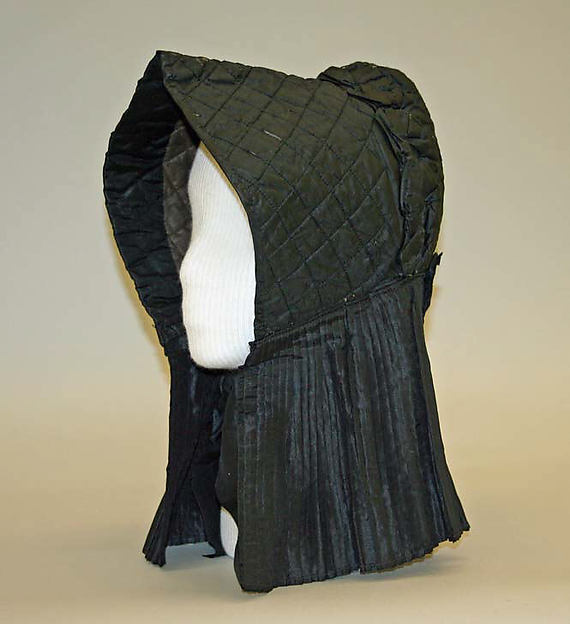 |
| Quilted bonnet of silk, 19th century |
 |
| Quilted and padded silk bonnet, 19th century |
 |
| Opera hood from Godey's, Jan 1861 |
 |
| The Princess Capote, featured in Der Bazar and Peterson's, 1862 |
 |
| Spanish Opera Hood, Godey's, 1863 |
Corded, quilted, or slat sun-bonnets protect the face and neck from sunburn, and may be made of light, even sheer, material for comfort the heat.
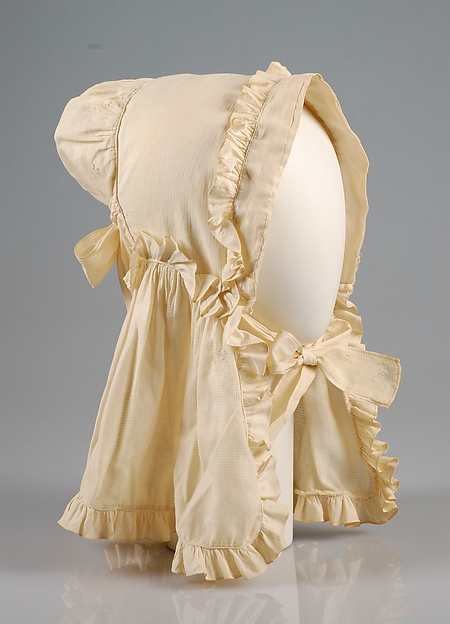 |
| Cotton sun-bonnet, c. 1860 |
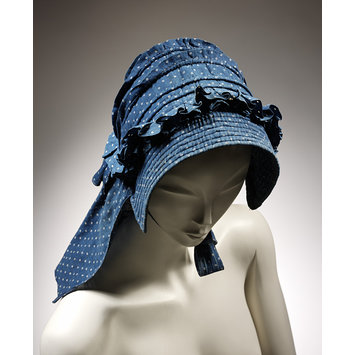 |
| Corded sunbonnet, cotton, 1850-1890 |
 |
| Slat sunbonnet, detail from At the Well (1864) by J. G. Brown |
Spanning between practical sun protection and fashion is the "capeline", a sort of drawn bonnet with a long curtain.
Veils
Bonnet veils can add sun/wind/bug protection over the face. These vary from simple affairs of gauzy fabric (wool, silk, even cotton) which fasten with buttons, ribbons, or pins, to elaborate confections of expensive net and lace. They were especially sought for travel, and also offered the wearer a certain privacy or anonymity--Mary Chestnut's diary mentions wearing them for travel, while in Dickens' Bleak House, Lady Deadlock employs one to conceal her identity and Esther Summers wears veils to hide her smallpox scars. Other period sources recommend dark veils, particularly in green or blue, to protect one's eyes from the sun. The two most common shapes are half-circles and rectangles. Mourning veils of black crape and long white wedding veils tend to be rectangular and much larger than ordinary bonnet veils.
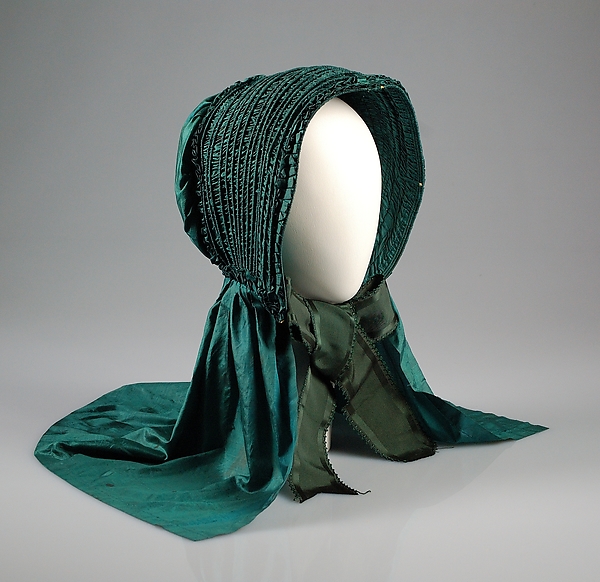 |
| "Capeline" Silk Bonnet, c. 1845 |
Bonnet veils can add sun/wind/bug protection over the face. These vary from simple affairs of gauzy fabric (wool, silk, even cotton) which fasten with buttons, ribbons, or pins, to elaborate confections of expensive net and lace. They were especially sought for travel, and also offered the wearer a certain privacy or anonymity--Mary Chestnut's diary mentions wearing them for travel, while in Dickens' Bleak House, Lady Deadlock employs one to conceal her identity and Esther Summers wears veils to hide her smallpox scars. Other period sources recommend dark veils, particularly in green or blue, to protect one's eyes from the sun. The two most common shapes are half-circles and rectangles. Mourning veils of black crape and long white wedding veils tend to be rectangular and much larger than ordinary bonnet veils.
 |
| Bonnet veil thrown back, detail from de Pujol's The Empress Eugenie and Her Court at Biarritz (1861) |
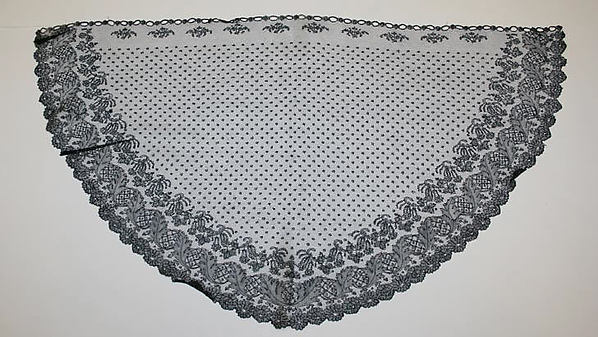 |
| Veil, 19th century |
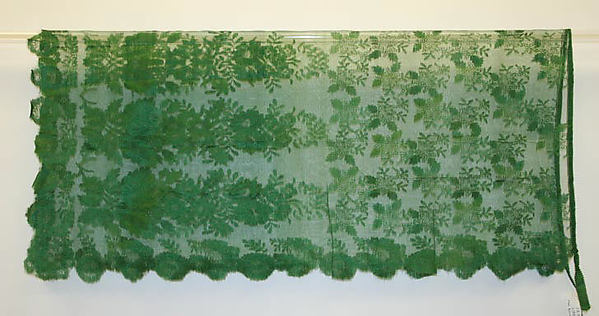 |
| Green veil, c. 1855 |
| Bonnet veil |
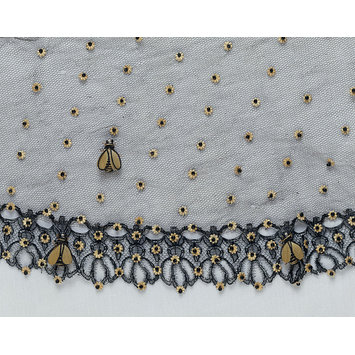 |
| A whimsical bonnet veil, 1860s |
References and Further Reading
See links under particular images for more information on a specific item or picture. Descriptions from the "Fashion Department" of Godey's for a given year are also useful; Peterson's is very amusing for the fanchon/empire split of 1865.
For additional research and images, search any of the museum sites previously listed for "bonnet"; check out The Graceful Lady's bonnet page; flip through period magazines such as Godey's Lady's Book, Peterson's (New Monthly) Magazine, Harper's Bazaar, Arthur's Home Magazine, Frank Leslie's Monthly, Der Bazar (German), and La Mode (French); also look to original CDVs, fashion plates, and genre paintings. To train the eye on bonnet shapes, looking at Timely Tresses' pre-made forms can help (no trimmings to obscure the lines).
Reproduction Bonnets and Patterns
For purchasing fashion bonnet forms and accessories, here are a few suppliers with good period designs:
Timely Tresses (bonnets, straw and buckram blanks, kits & supplies; hood and sunbonnet patterns)
A Milliner's Whimsy (straw forms)
Mrs. Parker's Millinery (bonnets, hats, and blanks)
The Dressmaker's Shop (patterns, supplies, straw forms)
I've previously collated some on-line instructions to make soft bonnets and hoods.
For those desiring clearer instructions, Anna Worden Bauersmith has an inexpensive hood pattern for sale.
Liz Clark's (very easy) sunbonnet pattern can also be made up as a tufted hood.
Subscribe to:
Comments (Atom)

